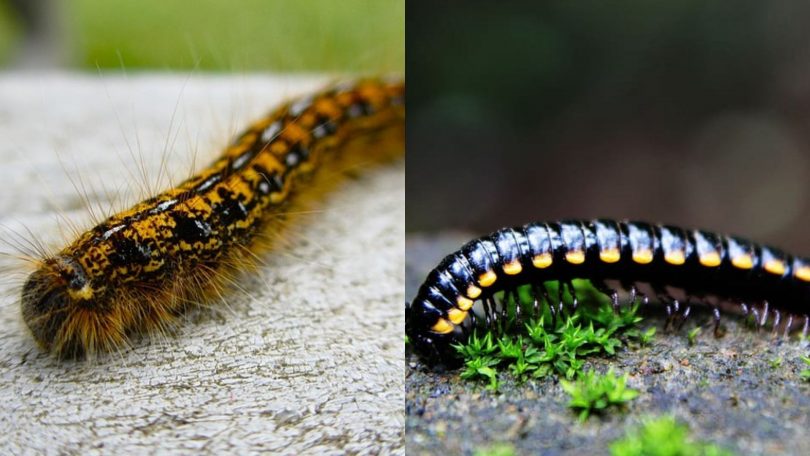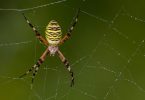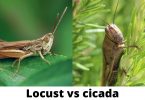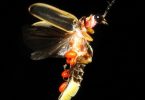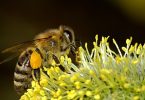There is a lot to know about the different species of caterpillar, but in this article our focus is the black caterpillar, and the brown caterpillar. So, in the preceding sections, a lot of important details will be shared about the brown caterpillar, and the black caterpillar.
In the life cycle of organisms, they all begin as eggs, go through the stages of nymph, larva and pupa, and then adulthood.
However, caterpillars are at the larval stage of organisms and insects that belong to the Symphytan and Lepidoptera order. Some of these insects are moths, sawflies, and butterflies. It is important to know that the lepidopteran and the symphytan both have eruciform body shapes.
Most species of brown and black caterpillar are herbivorous in nature, they feed on plants and on flesh too. In like manner, there are also a few of them that are not herbivorous, they feed on insects and are quite cannibalistic.
Different species of brown and black caterpillar are basically very voracious feeders, in addition to that, a good number of the different species of caterpillars are one of the most terrible pests that infest the crops in various farms, they also damage fruits and other products of agriculture they get in sight.
Regardless of the destruction that the species of brown and black caterpillar bring to the farm and all of the farm’s produce, the species of brown and black caterpillar are still highly valued for their economic importance, which includes the following: sources of human food, sources of animal food, sources of silk, and sources for the biological control of pest plants.
Species of Black Caterpillar

Judging from appearances, there are many species of caterpillars that are quite appealing to sight, and their outlook is alluring that one will think that they are entirely harmless. On the other hand, there are also some species of caterpillars that are quite fuzzy with lots of hair spines on their bodies, which makes them look quite scary.
Now these species of caterpillars are fuzzy and their bodies are decorated by hair looking spines, they are the species of Black caterpillars. Some species of this black caterpillar have very attractive colours, like the yellow marking and the orange markings.
From the description, it is clear that most species of the black caterpillars do not look very attractive, although they could as they progress through the cycles change into very beautiful moths and butterflies.
Also, one is prone to thinking that the different species of the fuzzy Black caterpillars, are harmful and probably sting, but it is not the case. In fact, most species of the black caterpillars are harmless, and their behaviour are the exact opposite of their actions, in that they may appear to be very deadly, but in reality, they are far away from being harmful.
Some of the species of the black caterpillars have very stiff hairs as well as very hairy bodies, which could be quite irritating but that does not mean that these species are harmful.
However, it is important to note that there are some species of the black caterpillars that are harmful with quite deadly stings. So do not assume that all species of the black caterpillars are harmless and do not sting.
In the succeeding sections, we will share with you a few things you need to know about the black caterpillars so that you can easily identify it any time at all.
What you should know about the species of the black caterpillars
By now you already know that one of the ways to identify the different species of black caterpillars is through its physical appearance, and how the body is fuzzy and decorated with hairs, as well as how they have different colours of markings. Some of them are orange and yellow, some are black too. However, there are other things that should be known about the species of black caterpillars which we will be sharing in this section.
Some species of black caterpillars have very firm hairs that could be as hard as spikes, which they use as defense mechanism from predators.
So, the fur on their bodies are usually as soft as wools although they could also be sore, this is largely dependent of the species of black caterpillars.
We will point out these further details by discussing some of the species of black caterpillars:
- Monarch species of black caterpillar
- Giant Leopard Species of black caterpillar
- Garden Tiger Moth Species of black caterpillar
- Woolly Bear Species of black caterpillar
-
Monarch Species of Black Caterpillar
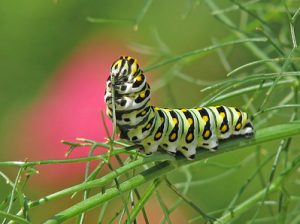
The Monarch species of black Caterpillar is best identified by the white colour and yellow colour stripes on its body. On a closer look, the monarch species of the black caterpillar have patterns or stripes that look like the pattern of stripe on the body of a lion. The Monarch species of black caterpillar are very aesthetic and appealing to the eye, the monarch black caterpillar eventually becomes a beautify monarch butterfly, which is after it passes the stage of the pupal in the life cycle of the butterfly.
2. Giant Leopard Species of Black Caterpillar

The giant leopard species of the black caterpillar are very beautiful in appearance; the giant leopard species black caterpillar have very fluffy appearance, and also have red bands in between the segments on their bodies, given them a red and a black fuzzy look.
These species of black caterpillars also have firm hairy black spikes that are needle like in shape, and could be as sharp as they appear. The black hairy spikes on the body of the caterpillar cover the body of the specie in such a way that the inner skin of the giant leopard’s body is not seen; hence, it is safe to conclude that the giant leopard uses the red bands on the segment of its body to defend itself from its fiery predators.
Also, when it comes to the size of the giant leopard, the Giant Leopard species of black caterpillars are usually about two inches in growth size.
If you have a garden, chances are that you will find them munching on the leaves of plants in your gardens, and if you spend time in your garden, you probably have been spending time with some quiet company. These species of black caterpillars do not sting, neither are they harmful, except one is brushed over by their sharp spiky hairs. More so, it is important to know that the giant leopard species of black caterpillars are mostly found in the East coast of the US, in parts of Mexico, in parts of Florida, and in parts of Texas.
3. Garden Tiger Moth Species of Black Caterpillar
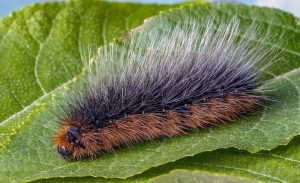
The Garden Tiger Moth species of black caterpillar also known as the wooly caterpillars, are also part of the beautiful species of the black caterpillars. These species also belong to the family of the Artica, and the genus of Eribidae crawling category of insects. This species of black caterpillar is as fuzzy as the other species of black caterpillars and they have black spikes which complement the orange lines and the grey white colours on the body of the garden tiger moth caterpillar.
Unlike in the other species, the orange line and the grey white line on the body of the garden tiger moth species of the black caterpillars are very visible as they crawl through surfaces, these lines cover up the spikes so that the black spike are rarely seen.
More so, the garden tiger moth species of black caterpillars are quite longer than the usual size of the other species of black caterpillars, with a length of six centimeters (6cm) which is equal to two point three inches (2.3 inches), and are mostly found on leaves where they feed.
Also, the Garden Tiger Moth species of caterpillars are also part of the species of black caterpillars that are harmless because they do not sting, however, like the other species of black caterpillars that have spikes, the spikes could prick the skin and could cause an irritation or a little harm on the body.
After the period of pupal before it becomes an adult butterfly or a moth, the garden tiger moth has very vibrant black colour and orange colour which gives it a very alluring appearance especially as it moves. However, after some weeks of the pupal period, the garden tiger moth species produces a moth that has black and orange wings, and pairs of white wings which also gives the moth a very aesthetic appearance.
4.Woolly Bear Species of Black Caterpillar
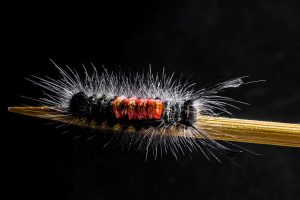
The woolly bear species of black caterpillars are one of the most common type of the species of black caterpillars. These species of woolly bear also have fuzzy hairs on their body just like the other species, they have bands that are orange in colour and are blended with black colour as well which makes it very easy to recognize them.
These orange and black colourful bands are usually found in the middle part of the body of the caterpillar, or at the back of the body of the woolly bear species of black caterpillar.
The woolly bear species of the black caterpillar also like the garden tiger moth species of black caterpillars has the ability to grow up to six centimeters (6cm) length, which is also equal to two point three inches (2.3inches)
When the woolly bear species of black caterpillar feels that there is danger around, or sense some vibes of an invading predator, the wooly bear species of black caterpillar quickly rolls into a ball, leaving the hairs all poked out as spikes in its body. When they are sure or the feel that the coast is clear, and that there is no more danger, the woolly bear species of black caterpillar unfurls back and crawls to a place it considers a safe place.
The wooly species of black caterpillar, also known as the Isabella Tiger Moth species of black caterpillar mostly feed on the leaves of herbs, leaves of trees and those of plants too.
More so, it is part of the species of black caterpillar that do not sting, although the spikes on its body can result in skin reactions, skin rashes, skin itching, and skin allergies.
Species of Brown Caterpillar

We will share details of the different species of brown caterpillar through describing these species.
1.Bright-Line Brown-Eye Moth Species of Brown Caterpillar
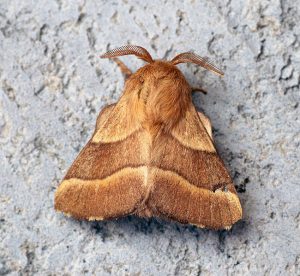
The Bright–line Brown-eye moth is a common species of the brown caterpillar mostly found in most parts of the British Isles.
The Bright-Line Brown-eye is also called the Tomato moth by most experienced gardeners because this species of brown caterpillars feeds on herbaceous plants, it especially feeds on the leaves and fruits of tomato.
The Bright-line Brown-eye species of the brown caterpillar are up to forty millimeters when this species is grown in sizes. However, the bright-line brown eye species of have very different shades of brown.
However, the bright line brown eye species of the brown caterpillar is best identified by the sprinkling of white specks, as well as the very bold black spots that are spread round the various parts of its body. Also, under the spiracle line of the bright line brown eye species of brown caterpillar is a line that is coloured yellow, and is best seen through the side view.
More so, after the pupal stage of the bright line brown eye species of the brown caterpillar, the specie grows into a full adult moth with a pair of wings that spans of about thirty-five millimeters (35mm), also the pair of wings generally become a warm light brown pair in colour, and has some slightly dark shades.
2.Elephant Hawk Moth Species of Brown Caterpillar
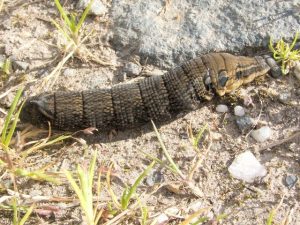
Another species of the brown caterpillar is the Elephant Hawk Moth caterpillar and its scientific name is the Deilephila elpenor. This species of brown caterpillar is named after the identification that the elephant hawk moth species of brown caterpillar looks like the elephant.
The elephant hawk moth species of caterpillar can also be identified by its brown colour with shades of grey, as well as the black spots it has all over its body. The elephant hawk moth species of brown caterpillar can also be identified by the oval shape of its head as well as the spots of eye on them.
The position of the eyes of the elephant hawk monk makes this species of brown caterpillar look quite scary to its intending predators who in turn go away from the elephant hawk moth species of brown caterpillar. Also, this species have a horn on its body, the end of the body precisely.
After the pupal stage of the elephant hawk moth species of brown caterpillar grows into an adult moth, with a size of about seven point five centimeter (7.5 cm), which is also equivalent to three inches (3 inches).
3.The Southern Flannel Species of Brown Caterpillar
The Southern Flannel is another species of the brown caterpillar. This species of brown caterpillar is also bio nominally identified as the Megalopyge opercularis.
In addition to that, the southern flannel species of brown caterpillar according to gardeners is also identified as the Puss species of brown caterpillar, or the puss caterpillar. Also, it is important to know that southern flannel species of brown caterpillar is a type of the fluffy hairy species of brown caterpillar, although it is a smaller type of the fluffy hairy species of the brown caterpillar.
More so, the appearance of the southern flannel species of the brown caterpillar is quite alluring as well as very aesthetic. The southern flannel or the puss caterpillar has a tail that is very hairy, and has a beige orange colour. Also, the body is decorated by pale orange hairs that are very soft looking, and are equally covered in rows of spines.
Furthermore, the southern flannel species of the brown caterpillar is also a type of the woolly caterpillar and like other wooly caterpillars, it has a line that runs through the left side and the right side of its body. Also, it is very important to know that the Puss species of brown caterpillar or the southern flannel species of brown caterpillar shares a striking resemblance with the species of disheveled orange toupee.
However, even though the southern flannel caterpillar looks harmless because of its soft fluffy look, the puss caterpillar is not a caterpillar to be taken for granted because the rows of spines that are seemingly harmless are quite harmful, also, they can sting badly, and sometimes their stings can leave the victims with rashes, allergic reactions, and a few more skin issues depending on which part of the body it stings.

